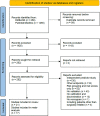A Systematic Review and Meta-Analysis of Prognostic Nomograms After UTUC Surgery
- PMID: 35847838
- PMCID: PMC9283688
- DOI: 10.3389/fonc.2022.907975
A Systematic Review and Meta-Analysis of Prognostic Nomograms After UTUC Surgery
Abstract
Background: Current guidelines recommend assessing the prognosis in high-risk upper tract urothelial carcinoma patients (UTUC) after surgery. However, no specific method is endorsed. Among the various prognostic models, nomograms represent an easy and accurate tool to predict the individual probability for a specific event. Therefore, identifying the best-suited nomogram for each setting seems of great interest to the patient and provider.
Objectives: To identify, summarize and compare postoperative UTUC nomograms predicting oncologic outcomes. To estimate the overall performance of the nomograms and identify the most reliable predictors. To create a reference tool for postoperative UTUC nomograms, physicians can use in clinical practice.
Design: A systematic review was conducted following the recommendations of Cochrane's Prognosis Methods Group. Medline and EMBASE databases were searched for studies published before December 2021. Nomograms were grouped according to outcome measurements, the purpose of use, and inclusion and exclusion criteria. Random-effects meta-analyses were performed to estimate nomogram group performance and predictor reliability. Reference tables summarizing the nomograms' important characteristics were created.
Results: The systematic review identified 26 nomograms. Only four were externally validated. Study heterogeneity was significant, and the overall Risk of Bias (RoB) was high. Nomogram groups predicting overall survival (OS), recurrence-free survival (RFS), and intravesical recurrence (IVR) had moderate discrimination accuracy (c-Index summary estimate with 95% confidence interval [95% CI] and prediction interval [PI] > 0.6). Nomogram groups predicting cancer-specific survival (CSS) had good discrimination accuracy (c-Index summary estimate with 95% CI and PI > 0.7). Advanced pathological tumor stage (≥ pT3) was the most reliable predictor of OS. Pathological tumor stage (≥ pT2), age, and lymphovascular invasion (LVI) were the most reliable predictors of CSS. LVI was the most reliable predictor of RFS.
Conclusions: Despite a moderate to good discrimination accuracy, severe heterogeneity discourages the uninformed use of postoperative prognostic UTUC nomograms. For nomograms to become of value in a generalizable population, future research must invest in external validation and assessment of clinical utility. Meanwhile, this systematic review serves as a reference tool for physicians choosing nomograms based on individual needs.
Systematic review registration: https://www.crd.york.ac.uk/prospero/display_record.php?RecordID=282596, identifier PROSPERO [CRD42021282596].
Keywords: UTUC; nomograms; oncologic outcome; prognostic models; upper tract urothelial carcinoma.
Copyright © 2022 Pallauf, König, D’Andrea, Laukhtina, Mostafaei, Motlagh, Quhal, Aydh, Yanagisawa, Kawada, Rajwa, Lusuardi, Soria, Karakiewicz, Rouprêt, Rink, Lotan, Margulis, Singla, Xylinas, Shariat and Pradere.
Conflict of interest statement
The authors declare that the research was conducted in the absence of any commercial or financial relationships that could be construed as a potential conflict of interest. The reviewer DE declared a shared affiliation with the author EL to the handling editor at the time of review.
Figures




Similar articles
-
Postoperative nomogram to predict cancer-specific survival after radical nephroureterectomy in patients with localised and/or locally advanced upper tract urothelial carcinoma without metastasis.BJU Int. 2014 Nov;114(5):733-40. doi: 10.1111/bju.12631. Epub 2014 Jul 27. BJU Int. 2014. PMID: 24447471
-
High systemic immune-inflammation index predicts poor prognosis and response to intravesical BCG treatment in patients with urothelial carcinoma: a systematic review and meta-analysis.Front Oncol. 2023 Nov 1;13:1229349. doi: 10.3389/fonc.2023.1229349. eCollection 2023. Front Oncol. 2023. PMID: 38023187 Free PMC article.
-
Development and external validation of a nomogram predicting prognosis of upper tract urothelial carcinoma after radical nephroureterectomy.Urol Oncol. 2019 Apr;37(4):290.e17-290.e24. doi: 10.1016/j.urolonc.2018.12.027. Epub 2019 Jan 8. Urol Oncol. 2019. PMID: 30630733
-
Risk Factors for Unfavorable Pathological Types of Intravesical Recurrence in Patients With Upper Urinary Tract Urothelial Carcinoma Following Radical Nephroureterectomy.Front Oncol. 2022 Apr 13;12:834692. doi: 10.3389/fonc.2022.834692. eCollection 2022. Front Oncol. 2022. PMID: 35494036 Free PMC article.
-
Prognostic value of preoperative lymphocyte-related systemic inflammatory biomarkers in upper tract urothelial carcinoma patients treated with radical nephroureterectomy: a systematic review and meta-analysis.World J Surg Oncol. 2020 Oct 23;18(1):273. doi: 10.1186/s12957-020-02048-7. World J Surg Oncol. 2020. PMID: 33097052 Free PMC article.
Cited by
-
Risk factors of falls in elderly patients with visual impairment.Front Public Health. 2022 Aug 22;10:984199. doi: 10.3389/fpubh.2022.984199. eCollection 2022. Front Public Health. 2022. PMID: 36072374 Free PMC article.
-
Increased urinary B2-microglobulin is associated with poor prognosis of upper tract urothelial carcinoma.Front Oncol. 2022 Oct 11;12:1008763. doi: 10.3389/fonc.2022.1008763. eCollection 2022. Front Oncol. 2022. PMID: 36303834 Free PMC article.
-
Risk prediction models for ovarian hyperstimulation syndrome: a systematic review and meta-analysis.BMC Pregnancy Childbirth. 2025 Aug 18;25(1):860. doi: 10.1186/s12884-025-07971-9. BMC Pregnancy Childbirth. 2025. PMID: 40826343 Free PMC article.
-
A nomogram for overall survival of second primary cancers following upper-tract urothelial carcinoma: a SEER population-based study.Transl Cancer Res. 2024 Aug 31;13(8):4131-4145. doi: 10.21037/tcr-24-515. Epub 2024 Aug 12. Transl Cancer Res. 2024. PMID: 39262482 Free PMC article.
-
Geriatric Nutritional Risk Index as a prognostic marker for predicting survival outcomes in patients with UTUC after radical nephroureterectomy.Sci Rep. 2025 Mar 14;15(1):8836. doi: 10.1038/s41598-025-93557-6. Sci Rep. 2025. PMID: 40087356 Free PMC article.
References
-
- Seisen T, Peyronnet B, Dominguez-Escrig JL, Bruins HM, Yuan CY, Babjuk M, et al. . Oncologic Outcomes of Kidney-Sparing Surgery Versus Radical Nephroureterectomy for Upper Tract Urothelial Carcinoma: A Systematic Review by the EAU Non-Muscle Invasive Bladder Cancer Guidelines Panel. Eur Urol (2016) 70(6):1052–68. doi: 10.1016/j.eururo.2016.07.014 - DOI - PubMed
-
- Favaretto RL, Shariat SF, Savage C, Godoy G, Chade DC, Kaag M, et al. . Combining Imaging and Ureteroscopy Variables in a Preoperative Multivariable Model for Prediction of Muscle-Invasive and non-Organ Confined Disease in Patients With Upper Tract Urothelial Carcinoma. BJU Int (2012) 109(1):77–82. doi: 10.1111/j.1464-410X.2011.10288.x - DOI - PMC - PubMed
Publication types
LinkOut - more resources
Full Text Sources
Research Materials
Miscellaneous

